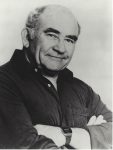1970S HOLLYWOOD MEMORIES: Underscore Classic Theatre Opener

People who remember the 1970s – or who vicariously wish they had been there by watching the nostalgic That 70s Show – will be in for a treat with the Classic Theatre Festival’s production of Neil Simon’s 1979 comedy, I Ought to Be in Pictures, running June 24 to July 17 at 54 Beckwith Street East in Perth. The script is full of references to 1970s Hollywood icons like James Caan, George Segal and Suzanne Pleshette. Also mentioned frequently is actor Jane Fonda, a hero to Libby Tucker (played by Alison Smyth), the show’s 19-year-old vagabond who has left New York to find her Hollywood screenwriting father after years of disconnection. For the Classic Theatre Festival’s Associate Producer, Matthew Behrens, the Neil Simon comedy brings back many memories of the years he spent in Los Angeles during the 1970s. The son of actors Bernard Behrens and Deborah Cass, Matthew was privileged to walk on the sets of shows ranging from Kojak and The Bionic Woman (where the trepidacious teenager almost fainted after meeting his hearth-throb, Lindsay Wagner) to Columbo and Baretta. He frequently visited the backlot of Universal Studios, where The Waltons was filmed, and where the studio hosted a world-renowned tour that really took off with the installation of a Jaws set complete with a ferocious automated shark. “Hollywood in the 1970s was still an industry very much in transition from the glamour of the golden years and the big marquee stars, like Betty Hutton and Robert Young, to the newer heavyweights, like Dustin Hoffman and Candice Bergman,” recalls Behrens, who points out that the power of network TV in those years was still potent given a three-channel universe and the still-dominant role of print and radio. “We tend to forget that entertainment options in the pre-internet world were comparatively limited, and so the concentration of viewers you would get for a show like Mary Tyler Moore or MASH was absolutely huge. A guest spot on episodic television, the like of which my father did quite a few, would be seen by millions.” That world of 1970s Hollywood forms the backdrop to I Ought to Be in Pictures, when “the business,” as it was called, was a significant economic driver for the state, employing thousands of performers, technicians, and makeup artists like a key character in the show, Steffy Blondell (played by Barb Scheffler), who works at Columbia Pictures. She’s in a relationship with Herb Tucker (played by William Vickers), a screenwriter with a massive case of writer’s block. Tucker rails against the facets of LA life that are all too familiar to the huge Canadian expatriate community who live there, from the narrow range of seasons (364 days of sunshine, 1 day of torrential downpours when there isn’t a drought) to the fear that the whole state will break off and sink into the ocean following “the big one,” an earthquake like the one that played theatres worldwide in “sensaround” in the mid 1970s. “Los Angeles is a… Continue reading





